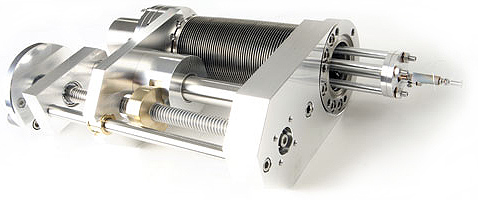|
Kelvin Probe Actuator
A variety of ingenious mechanisms have been used to generate
the required spacing modulation including rotation, piezo-electric and
voice-coil drivers- even piano wire has been attempted! In terms of vacuum
applications piezo-electric and voice coil drivers remain the easiest to
implement. The figure above shows an example of an UHV compatible head stage
using a voice coil driver. The majority of the probe construction is stainless
steel including the suspension system which consists of three laser-cut
diaphragm springs. The vibration frequency (30 - 300 Hz) and amplitude of
oscillation (0.01 - 1.00 mm) and probe mean spacing (± 50 nm) are controlled by
a digital oscillator located in the host PC.

The voice-coil driving system is deliberately well removed
(250 mm) from the tip ensuring that no traces actuator signal can be detected on
the input signal, i.e. driver talk-over. The stainless steel tip customarily has
a diameter of 2-3 mm and can be gold plated if desired. The suspension system
can be easily adapted to multiple tip geometry allowing both high and low
spatial resolution on one head stage.
Alternative piezo-electric actuator designs such as Besocke's
are customarily located in close proximity (10-20) mm from the sample. My
experience of such drivers indicates that capacitive coupling in the form of
talkover noise can pose considerable problems particularly if a LIA based self-nulling
detection system is used. In such cases it can be difficult, in the vacuum
environment, to distinguish real changes in Vc from stray capacity effects- a
'clean' Kelvin signal is essential for high resolution measurements.
|

Single Electron Transistor Device results scan
Kelvin Probe 50micron tip measuring a Single Electron Transistor Device
Scanning Kelvin Probe
UHV Kelvin Probe
Solar Panels
Scanning Kelvin Probe
|


